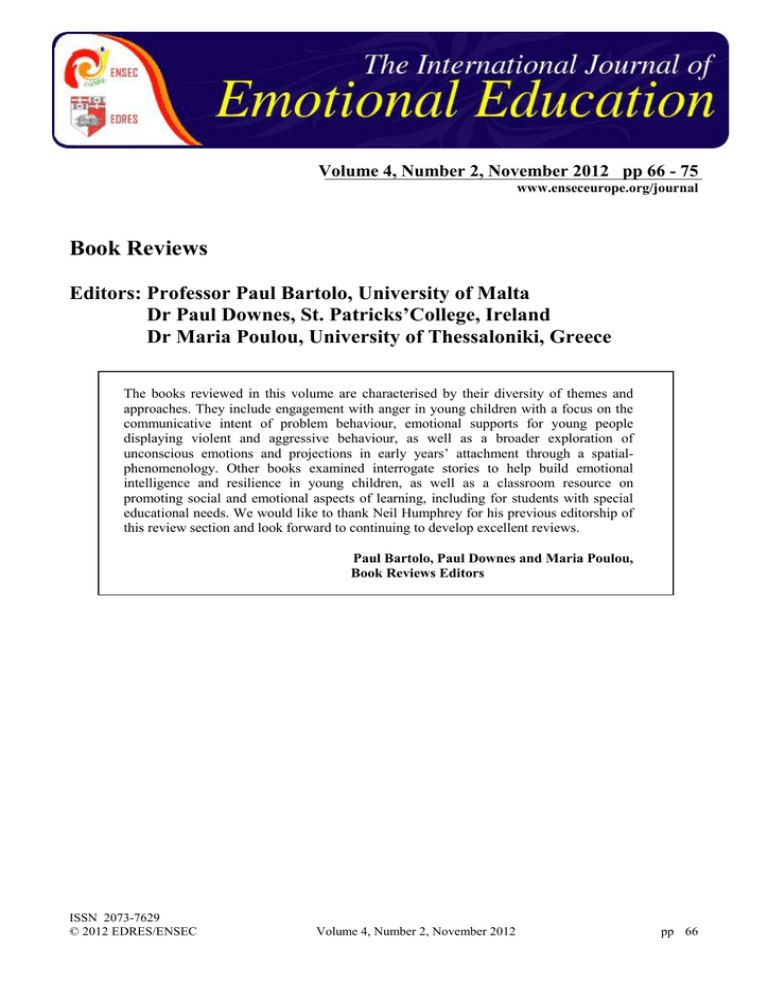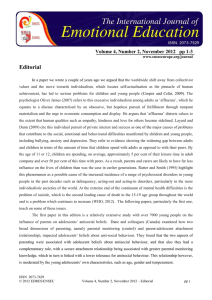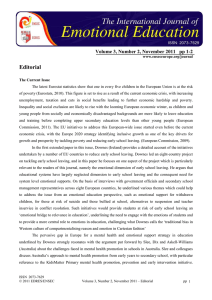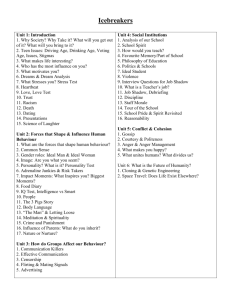Book Reviews
advertisement

Volume 4, Number 2, November 2012 pp 66 - 75 www.enseceurope.org/journal Book Reviews Editors: Professor Paul Bartolo, University of Malta Dr Paul Downes, St. Patricks’College, Ireland Dr Maria Poulou, University of Thessaloniki, Greece The books reviewed in this volume are characterised by their diversity of themes and approaches. They include engagement with anger in young children with a focus on the communicative intent of problem behaviour, emotional supports for young people displaying violent and aggressive behaviour, as well as a broader exploration of unconscious emotions and projections in early years’ attachment through a spatialphenomenology. Other books examined interrogate stories to help build emotional intelligence and resilience in young children, as well as a classroom resource on promoting social and emotional aspects of learning, including for students with special educational needs. We would like to thank Neil Humphrey for his previous editorship of this review section and look forward to continuing to develop excellent reviews. Paul Bartolo, Paul Downes and Maria Poulou, Book Reviews Editors ISSN 2073-7629 © 2012 EDRES/ENSEC Volume 4, Number 2, November 2012 pp 66 1. Talking treasure: Stories to help build emotional intelligence and resilience in young children Author(s): Hankin, V., Omer, D., Elias, M.J. & Raviv, A. Publisher: Research Press: Champaign, Illinois Year of Publication: 2012 ISBN: 9780878226726 Talking treasure: Stories to help build emotional intelligence and resilience in young children is a newly published collection of short stories, comprising seven original stories written by the book authors and three retellings of classic fables, including Aesop’s fable ‘The Oak and the Reed’. The collection is recommended for children between the ages of 4 and 8, though it could be enjoyed by children outside of this age bracket, and is intended to be read to them by their parents, teachers and other significant people. Through the voices of their characters, the stories discuss themes such as the siblings’ rivalry, hidden values in others, benefits of taking risks, taking other persons’ perspective and overall the importance of expressing one’s inner feelings. Given that most children project different aspects of the self onto the stories they hear, the stories are intended to be a starting point for discussing the above themes and to encourage the children, through providing them with the vocabulary to name and talk about feelings, to reflect on their own emotional states. In discussing a set of themes relevant for most young children, the stories differ from those commonly called ‘therapeutic’ ones such as for example Norah Davis’s collection of stories ‘to heal abused children’. Nevertheless, these stories, like indeed several others, carry the empowering value of storytelling to explore one’s own identity that was emphasised by Bettleheim in his classic ‘The Uses of Enchantment’. The authors emphasise in the introductory section that the book is largely on how to communicate meanings intended to build self-resilience and self-esteem. This emphasis on the act of communication, well reflected in the title that begins with the word ‘talking’, is augmented by a ‘Parent and Teacher EQ Guide’ (EQ stands for emotional intelligence) – a supplementary addition at the end of each story that helps to discuss with the child what she or he understood from the story. The supplements are in three parts, firstly focusing explicitly on the meaning of the story and on personal connections that children may be making (‘Inside the Talking Treasure’), secondly giving suggestions for discussion (‘Exploring the Talking Treasure’) and thirdly providing ideas for activities to do with the children beyond the reading (‘Spreading the Talking Treasure’). These supplements should be highly recommended for early years’ practitioners as guides on how to teach reading comprehension strategies. Given a wide recognition in the early childhood literature that it is the quality of reading, as opposed to the reading quantity and its content, that matters most - especially for the development of language and literacy - these supplements are the most valuable parts of the book as they encourage the kind of responsive and dialogic quality reading. ISSN 2073-7629 © 2012 EDRES/ENSEC Volume 4, Number 2, November 2012 pp 67 The stories are not illustrated throughout containing only one black and white picture at the start of each story which is a significant weakness of a book intended to be shared with children as young as 4 in a joint attention reading with a parent. Lack of illustrations may make these stories more suitable for older children, a group class reading or simply for retelling. The stories differ in length, from some very short ones to some more complex ones sufficiently multi-layered to offer different layers of meaning to different children of different ages and experiences. This book is more than a collection of stories as it gives explanation on the meaning of the stories and the reasons for their inclusion, the activities to further explore the themes of each story as well as a definition of emotionally intelligent parenting together with an account on the importance of fostering emotional intelligence in early childhood. In addition to its intended value of increasing self-awareness and empathy in young children, the book thus offers a significant educational aspect for the adults who intend to read the included stories to the children they live or work with. Sylwia-Kazmierczak Murray St. Patrick’s College, Drumcondra, Dublin City University, Ireland 2. Equipping Young People to Choose Non-Violence. A Violence Reduction Programme to Understand Violence, Its Effects, Where it Comes From and How to Prevent It Author(s): Heerey, G. Publisher: Jessica Kingsley Publishers Year of Publication: 2012 ISBN: 978-1-84905-265-8 This book could be read from different perspectives as it is focuses on a complex issue (violent and aggressive behaviour by the young person) and addresses a wide variety of professionals working with this category of young person: ”social worker, teacher, youth worker, youth justice worker, mental health worker or counsellor” – p.14. The users of this book could be practically anyone with interest in exploring and addressing the use of violence as it goes beyond a simple assistance programme for young people with ISSN 2073-7629 © 2012 EDRES/ENSEC Volume 4, Number 2, November 2012 pp 68 behaviour problems. This resource promotes and makes operational the explicit belief that acknowledgement and assuming responsibility for a violent behaviour are key conditions to make young people more equipped to choose non-violence. And, I would add, these are also key conditions for a successful facilitator, aiming at making a difference and positively influencing young people with a record of aggressive behaviour. The first part of the book, creating the background of the intervention programme, is attentively presented, playing an important role in avoiding typical misunderstanding caused by the lack of clarity concerning the relevance of different theoretical underpinnings for the overall programme. Heery explains in the introduction that the aim of this part is to make this ”complex material accessible to busy and hard-pressed workers – to make things simple but not simplistic – and to give clear guidance on the approach” - p.14. He succeeds in reaching this goal offering to the reader a clear introduction to the World Health Organisation ecological model on violence. However, the programme theory base would benefit from a more in-depth presentation of different theories underlying the programme, from restorative ethos (values, principles) and change and motivation theory to solution-focused and strengths-based approaches, as well as an explicit justification of the (logical) links between them. In particular, self-efficacy perception theories (Bandura 1997; Viau, 2004) from the perspective of motivating strategies could offer a stronger foundation as part of the main ideas underpinning the prescriptive dimension of the book. The author discusses gender issues, learning difficulties and different addictions (alcohol and drugs) as specific issues for the programme design and delivery; it is a good way of introducing the complex theme of risk of violence and its management. We need to understand how the intervention programme can follow the ambitious aim to assist in the prevention of all types of interpersonal violence, while acknowledging the complexity and limitations of assessing the risk and determine accurate persons’ violence profiles. And Heery aptly highlights that beyond different explanatory theories, ”accurate prediction of violent behaviour by a particular person is still out of reach” (p31) and that "The Choosing Non-Violence programme reflects the reality that there is no universal agreement as to why some people are violent” (p32). Setting the question aside, the author proposes to focus on a different but effective approach, ”encouraging each young person to fully explore their behaviours, the consequences for their victims, themselves, their families and communities and to seek if possible to restore the harm done” (p32). The book concludes the first part with two chapters providing practical recommendations for initiating and delivering the programme, including experience-based suggestions on evaluating an intervention that sucessfully reflects and addresses various emotional support needs of the young people with a violent record. How well went my intervention? What we have learned? What could be changed in the future are ”universal” questions of every project building the evidence base and here we could expect a more specific analysis of possible methodologies, techniques and tools that could be used to ”hear the voices of the young people at the receiving end of this intervention” (p 45). The second part of the book details the 12 sessions of the Choosing Non-Violence Program, indicating in each case the main objectives followed, the content, methods and processes and also providing a ISSN 2073-7629 © 2012 EDRES/ENSEC Volume 4, Number 2, November 2012 pp 69 wide variety of tools as examples. All sessions are of high relevance for a facilitator aiming at working with young people both for intervening in cases of violence but also for preventing violence for at-risk groups. Simple but effective, the sessions provide excellent examples and suggestions also for teachers to assist their students in their journey of self-discovery, an objective often ignored in the search for high academic performance in a field. In conclusion, I have found reading the book both useful and challenging. It is a resource offered, as indicated by the author, also very much in the spirit of allowing to ”take what helps and leave the rest”. From my perspective, there were very few things to be left out. Reference: Bandura, A. (1997). Self-efficacy: The exercise of control. New York: Freeman. Viau, R. (2004). La Motivation en context scolaire. Quebec: Editions du Renouveau pedagogique. Ciprian Fartusnic Institute of Education Sciences Bucharest - Romania. 3. Little Volcanoes: Helping Young Children and their Parents to Deal with Anger Author(s): Pudney, W. & Whitehouse, É. Publisher: Jessica Kingsley Publishers Year of Publication: 2012 ISBN: 978-1-84905-217-7 Approaches to the management of problem behaviours in children have traditionally focused on punitive rather than educative procedures, or on the shaping and management of behaviour through various schedules of reinforcement. Such approaches depended on the application of knowledge about what produced data-based effects, as opposed to asking moral and ethical questions about why children were protesting their contexts, and once these questions began to be asked, researchers were empowered to investigate whole new avenues of enquiry, such as the functions of challenging behaviour. As a result, more recent work has focused on the communicative intent of problem behaviour, and Little Volcanoes: Helping Young Children and their Parents to Deal with Anger by Pudney and Whitehouse (2012) is rooted in this latter approach. It explores issues of anger in young children within a framework provided by Attachment Theory; as such this work ISSN 2073-7629 © 2012 EDRES/ENSEC Volume 4, Number 2, November 2012 pp 70 seeks to elucidate the sources and functions of anger in young children, rather than simply aiming to control or manage behaviours. The book is aimed at parents and those who work with young children in caring and educational settings, and it provides strong practical approaches underpinned by solid theoretical foundations. It examines attachment disorders, and the ongoing negative effects of violence, both witnessed and directly experienced by young children. It supports both parents and professionals to understand the needs of children of different ages, and identifies potential issues related to anger at different developmental stages, particularly focussing on the need to support young children to cope with strong feelings. The book also explores gender differences in development and expression of anger in children. This is a particularly important consideration when one takes into account female dominance of caring and educational settings for young children. The authors argue that often female carers and parents fail to appreciate ‘boy energy’ and the extent to which socialisation can result in boys repressing nearly all emotions other than anger, “because anger is the one empowering emotion that allows them to fight back and protect” (p 32). The role of fathers is deconstructed in this context; much of what is written elsewhere on gender differences in parents’ involvement with their children has been from a feminist perspective, viewing increased involvement of mothers as evidence of women suffering an injustice, as opposed to recognising the disempowerment of men as fathers through their exclusion from their children’s lives. Pudney and Whitehouse’s book recognises the importance of fathers, and aims to empower them in their involvement with their children. However, while gender issues are well explored, the book gives limited exposition of understandings of anger and appropriate responses to it in different cultural contexts. Key concepts of this book include the idea that behind anger there are feelings of hurt, fear or powerlessness; that close bonding and attachment allow children to grow with safety and trust; and that stress and fear increase our need to use anger for defence while good self-esteem means we have less need for anger. The strength of the book lies in its identification of various approaches to supporting children showing anger, ranging from setting consistent boundaries to distraction techniques and the development of ‘calming nurture’. At the core of this work is the Rogerian concept of ‘empathy’, and while some ideas may be somewhat aspirational (such as a tax on violent content on television and in film to be used to fund solutions to the problems caused by modelled violence), most of the book’s content is practical and useful, and the book ends with stories and poems about anger that could form the foundation of constructive explorations of anger with young children for parents and professionals alike. Leah O’Toole Marino Institute of Education, Dublin, Ireland ISSN 2073-7629 © 2012 EDRES/ENSEC Volume 4, Number 2, November 2012 pp 71 4. Intelligenza emotiva e integrazione scolastica Author(s): Morganti, A. Publisher: Carocci Faber, Italy Year of Publication: 2012 ISBN: 978-88-7466-642-3 By drawing on her extensive experience in the field, Annalisa Morganti has written an accessible volume to increase awareness of the central role of emotions in learning, with a particular focus on promoting the inclusion of all students, especially those with special educational needs. The book presents an arguably comprehensive theoretical framework on social and emotional education, and contains a substantial number of suggestions on how to promote social and emotional education through the creation of an inclusive classroom community. The volume has two main sections, namely paths of knowledge, - knowledge on how to teach - paths of practice - putting knowledge into practice. The first section provides a blueprint on what to do to raise the school staff’s awareness on the social-emotional aspects of learning. Some main theories and research findings on the importance of emotions in learning are presented at the beginning of the first section. These include amongst others, the relationship between emotions and cognitive development, the neurobiology of emotions, the theory of multiple intelligences, and the construct of emotional intelligence. The issue of disability is introduced through two case studies, namely Paolo, a child with Down’s Syndrome, and Federico, and the differences and similarities in their social and emotional needs. CASEL’s (Collaborative for Academic, Social and Emotional Learning) five key competencies in social and emotional learning are discussed as a source of curriculum goals. The first section of the book concludes with an overview of some main concepts, processes and stages of emotional development and the recognition of emotions in typical and atypical development. The second section of the book is designed to focus attention on educational practices which promote inclusive social and emotional education in primary schools. Morganti argues for a learner–centered approach “to give value to individual students, their experience, perspectives, socio-cultural background, talents, interests, skills, taking the form of effective teaching practices in promoting the highest levels of motivation, learning and achievement for all students” (p. 77). Furthermore, the author offers an excellent range of practical tools and ideas that can enrich the teachers’ practice in supporting the social and emotional learning of students in classroom contexts. Classroom group activities in emotional awareness, social problem solving, self-regulation, conflict management and cooperative learning are presented, with relevant examples of children's activities in these topics. At the end of the second part, the author emphasizes the teachers’ role and competencies in enhancing diversity in the daily primary school curriculum. The classroom teacher becomes a benchmark in changing school culture through embracing an ISSN 2073-7629 © 2012 EDRES/ENSEC Volume 4, Number 2, November 2012 pp 72 innovative professional profile. The author describes a “Quality Teacher” (p. 131) emphasizing the knowledge and skills necessary to achieve quality inclusion by arguing what we need teachers with “a new dynamic frame of mind to build well-structured curricula and to develop appropriate learning situations related to the age of students, their own characteristics – sometimes very special - and context in which their work”(p. 131). The most important strength of the book is the focus on the need to include the social and emotional aspects of learning in the education of children with special educational needs, which the author defines as being “part of the objective to ensuring the access to good quality primary education for all student by 2015” (p. 143). Although the text is written in Italian and is targeted for a national audience, it provides innovative educational knowledge and practice across cultures, particularly ones targeting learning support teachers and the ways in which they can support the social and emotional aspects of learning of students, including those with special educational needs. Moreover, an extensive bibliography at the end provides a useful resource for facilitating the development of social and emotional learning and the education of children with special educational needs through an inclusive curriculum prospective. Overall, this book can be considered as a very useful and accessible resource for classroom practitioners and other educators in their efforts to promote the social and emotional aspects of learning for the whole primary school classroom, including students with special educational needs. Valeria Cavioni University of Pavia Italy 5. The Primordial Dance - Diametric and Concentric Spaces in the Unconscious World Author(s): Downes, P. Publisher: Oxford/Bern: Peter Lang Year of Publication: 2012 ISBN: 978-3-0343-0760-4 The driving question this book asks is whether a spatial-phenomenological structure exists, which is of a primordial, unconscious dimension, and which influences human experience. In attempting to answer this question Paul Downes takes the reader on a cross-disciplinary journey, revisiting an array of philosophical, psychological and anthropological arguments. His work refashions the main tenets of the work of Freud, Jung, Carol Gilligan, R.D. Laing, Kant and Foucault and interprets them in terms of this hidden unconscious ISSN 2073-7629 © 2012 EDRES/ENSEC Volume 4, Number 2, November 2012 pp 73 axis: primordial spaces of diametric and concentric structures. He proposes a novel approach to understanding the philosophy of early Heidegger and Derrida and interprets concentric and diametric spaces as dynamic, directional projections which explain core features of Heidegger’s primordial and derivative temporality. The author looks to structural anthropology and Lévi Strauss’ reference to examples of concentric and diametric structures. Downes claims that the basic schema for western logic is associated with a western preference for diametric–dualistic over concentric structures of relation and argues for a primordial, crosscultural spatial discourse which operates at different levels of description. From my own Maltese perspective, it is interesting to note that children’s first drawings are circles, and suns, reminiscent of the Chinese Mandala, just as the spiral motifs and the round bodies of the goddess of fertility were the first symbols employed by the early inhabitants of our islands. As an additional example of ancient concentric structures to those highlighted by Downes, the aerial view of the Ggantija Temples in Gozo (dating back to 3000BC) reveals a series of concentric figures, assembled to resemble the body of the mother goddess, giver of life and symbol of fertility. I wonder whether it is possible that these too are projections of man’s early psychic experience, before the emergence of conscience, and prior to the emergence of the ego ? Could these be a portrayal of man’s beatific existence, of the state of sleeping peacefully in the womb, at one with mother, mother goddess and mother earth? The need for connection and consistent relationship, which is a need for concentric structured experience and relation, is, as Downes says, present in diverse cultural contexts. Is it possible that with the formation of the individual and collective ego and subsequent differentiation a shift to more diametric structures occurred? Downes coins the term “concentric deprivation” and claims that avoidant, ambivalent and disorganized attachment patterns, so widespread in today’s world, are part of a diametric spatial projection. There is therefore a common projected space underlying insecure attachment. Difference is needed for ego formation and objectification and unity may feel overwhelming and obliterating. The author enters Laing, Jung and Freud’s Schreber’s world of psychopathology and examines their descriptions of the split self and the attempt to separate from interpersonal communication often observed in schizophrenic, schizoid, autistic, and paranoid states, where a concentric mode of relation is not possible. A middle mode seems therefore necessary, one which is not symbiotic and engulfing, neither is it diametric or separate. It is one in which the preferred state is connection, trust and confidence. In his chapter on Freud, he posits a spatial reinterpretation of the psychic subject in repression and early childhood experience. He thus makes a claim for the need to shift to a more intense understanding of cross-culturally meaningful spatial and systemic understanding of Freud’s work on the unconscious. He also examines projected structures in modernist art – e.g. in Munch’s Scream, as well as in Klimt’s “The Kiss”, in which a primordial opposition between diametric and concentric structures of relation is visible in the rectangular and round patterns on the painting, which Downes sees as structures of primordial ISSN 2073-7629 © 2012 EDRES/ENSEC Volume 4, Number 2, November 2012 pp 74 experience. He argues for a spatial-phenomenology, in which intuition needs to be interpreted in spatial terms to encompass emotion and dynamic movement. The author also seems intent on uncovering a primordial spatial discourse prior to language and advocates the movement beyond socially constructed language games. He also posits a space prior to subjectivity and pure reason and sees diametric and spatial projection as an ontology underlying cognitive science. With this seminal work he challenges postmodern claims that reduce truth and experiences to mere social and cultural constructions. He opposes the reduction of experience to reasoning, and attempts to extend the boundaries of human experience to encompass different modes of experience which go beyond cognition. In challenging the binarism present in the “us-versus-them”, “western-versus-oriental” discourses, Downes attempts to breach the divide between human beings. He also exhorts against the splitting of human subjects themselves, and warns of the peril of Cartesian divisive thinking, still prevalent in our discourses. In my view, due to Paul Downes’ embracing of the various disciplines in his treatise, his argument for crosscultural prevalence of spatial structures and his advocacy of connective structures of relation over divisive ones, we may consider his work as an inclusive endeavour, a quest for unity and relation which is, in itself concentric. Greta Darmanin Kissaun Department of Psychology University of Malta ISSN 2073-7629 © 2012 EDRES/ENSEC Volume 4, Number 2, November 2012 pp 75





